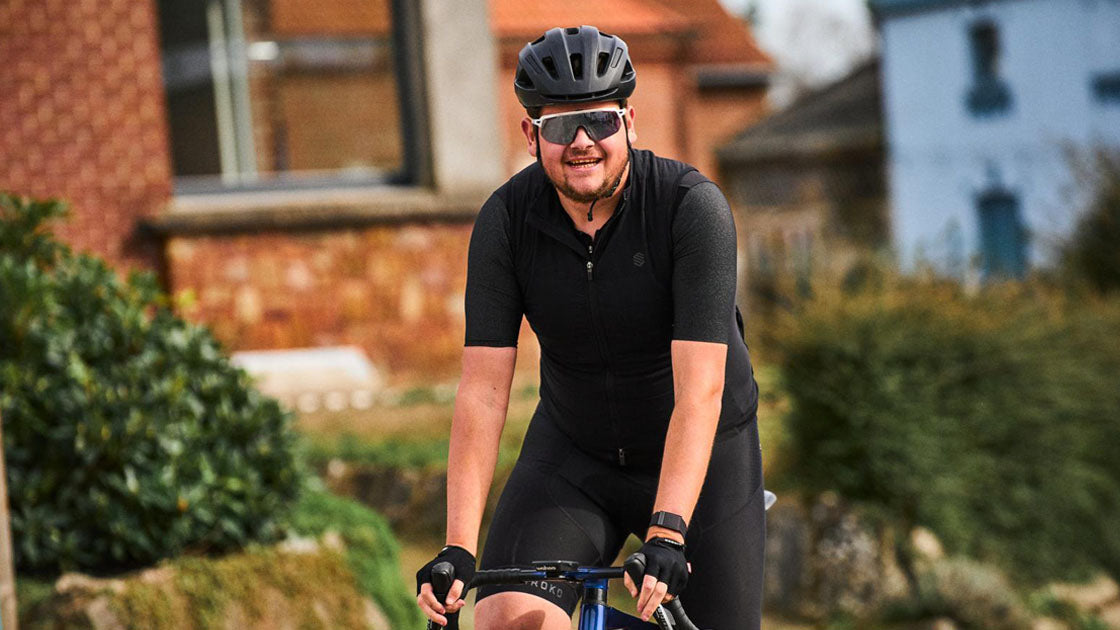The standard weight-loss advice is simple: eat less, move more. So not fueling during long rides should help you lose weight faster…right?
Not exactly.
In fact, skipping fuel might be what’s stalling your weight loss.
Take Benji Naesen as an example. He gave himself a challenge to do a Zwift race every day until he won. But he made the mistake of not fueling with carbohydrates during those rides.
Ironically, he ended up gaining weight during this period.
Why? Because Benji was hungry after the sessions. So hungry that he ended up eating more than he'd burned on the bike.
It wasn’t lack of willpower. It’s physiology.

You can hear more about Benji's journey (plus cool stories from his time as Cycling Analyst for Jumbo-Visma) on the Nduranz podcast.
Eat On the Bike So You Won’t Eat on the Couch
Energy expenditure should be about balance: If you burn 1,000 calories, eating 1,000 calories will stop the hunger.
But the brain doesn't work this way. You often still feel hungry even after eating more than you burned.
Exercise Physiologist Dr. Tim Podlogar has a theory as to why this occurs—and it has to do with the brain.
The Brain Doesn't Care You Burned 1,000 Calories
Carbohydrates are the body’s preferred source of fuel during exercise. The body stores carbohydrates in the body as glycogen:
- Muscles Glycogen: Used for movement
- Liver Glycogen: Used to keep the brain and other organs running
Both of these stores get depleted if you don't fuel a long ride. Your muscles feel tired when its stores are low. But when your liver stores are low, your brain panics.
And it won’t stop panicking until your liver glycogen is full again. So, your brain sends out hunger signals. You start to eat and eat.
Here’s the problem: the muscles are greedy.
You eat. But the greedy muscles snatch up the carbohydrates first to refill their own stores, leaving your liver low.
You continue eating, but your brain is still screaming, “I’m hungry”—even though you’ve technically consumed enough calories to replace those burned on the bike.
Fueling Prevents Yo-Yo Binges
If you’ve fueled properly, your liver glycogen should be nearly full at the end of the session.
Your brain won’t be screaming and you won’t feel the urge to binge on sugary and high-fat foods. As Dr. Tim says,
“If I don’t eat on the bike, I could empty a jar of jam afterwards. But when I fuel properly? I might feel dead, but I hardly feel hungry at all.”
This is especially important since yo-yo dieting is what often leads to weight gain. Instead of trying to rely on willpower alone, give your body what it needs so you don’t have uncontrollable cravings after your ride.
Fueling Makes Training Easier—So You Keep Showing Up

Another reason not fueling can sabotage weight loss? Consistency.
When you run low on carbohydrates, you feel sluggish. Power output drops. Rides feel miserable.
And if your rides feel miserable, how likely are you to keep showing up for your next session?
Not very.
By contrast, proper fueling lowers your Rate of Perceived Exertion—or how hard the effort feels. The same watts feel easier, your mood is better, and you’re more likely to enjoy the ride (or at least not suffer through it).
Fueling also means you recover better. Your muscles get the energy they need to start repairing during the ride, which means less post-ride fatigue, fewer cravings, and you bounce back faster for your next session.
This matters.
Because consistency is what drives long-term weight loss. If you feel better and recover faster, you will train more often, your fitness will improve, and you will burn more calories—and may even enjoy the process.
Think of it like this: you’re not just fueling your legs—you’re fueling your motivation, your recovery, and your routine.
But Doesn’t Fueling Prevent Fat Burn?

One myth in endurance sports is that not fueling a ride will help you burn fat during that ride.
But physiologically, that’s not how it works.
Even during low-intensity sessions, your body doesn’t solely use fat for energy. It uses a blend of fats and carbohydrates. As intensity increases, carbohydrates become the dominant fuel because the body doesn’t have enough oxygen to efficiently burn fat.
Limiting fuel intake doesn’t mean your body switches to burning fat. It just means you get tired more quickly.
Low-Fuel Training Should Be the Exception, Not the Rule
Yes, there are times when training with low fuel availability (aka carbohydrate periodization) can be useful—for example, when doing very easy rides under 90 minutes. This may train the body to oxidize fat better and increase adaptations.
However, these “train low” sessions come with serious risks (and the research isn’t even clear about the benefits).
Because of this, Dr. Tim says that train-low sessions should only be attempted once desired training status has been achieved and performance improvements have plateaued.
What really matters for fat loss is overall calorie deficit.
Calorie Deficit Needs to Be Strategic
Yes, you need to be in an overall calorie deficit to lose weight.
But you don’t want to diet on the bike.
It’s smarter to keep energy on the bike—where it directly supports performance, recovery, and consistency. Off the bike is where you have more control. That’s where you can cut calories by making strategic food choices, managing portions, and opting for low-calorie, high-satiety foods.
How Large Should the Calorie Deficit Be?
There’s no right answer. For some cyclists wanting to lose weight, it might be a deficit of 500 calories per day. For others, it might be 1000 calories—though that’s harder to maintain and still perform well.
It will likely take some tweaking to figure out how much deficit you can handle without feeling exhausted or an uncontrollable urge to binge on an entire pizza after each ride.
By the way, fitness tracker and food label calorie counts are not always accurate. Relying on these numbers can undermine your weight loss progress.
How Much to Fuel on the Bike for Weight Loss?

You don’t need to match fueling with calories burned during your ride. For example, if you burn 1,200 calories on your ride, you don’t need to consume 1,200 calories before and during that ride.
Instead, Dr. Podlogar says fueling amount depends on power output.
For very hard endurance rides, you will likely need 60 g to 90 g of carbohydrates per hour to keep liver glycogen topped off. For shorter, less-intense rides, amounts of 20 g to 45 g per hour will likely be enough.
What about Really Hard Sessions?
Dr. Tim says that you don’t need more than 90 g/hour. Only professional athletes need to fuel over this amount—and it’s not necessarily for performance. Rather, it’s about making sure they can survive because they create insane calorie deficits in the month.
Use Our Fueling Calculator
Still not sure how much fuel you need? Don't worry. We've simplified it with our Fueling Calculator. Just put in your info and the calculator will do the rest.
Because fueling doesn't have to be complicated.

